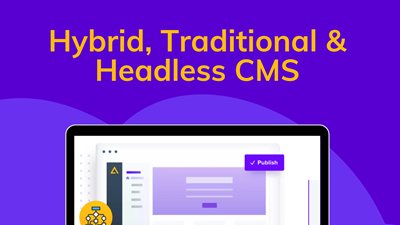The Role of Enterprise Headless CMS in Digital Transformation Strategies


The Digital Imperative
In an era when digital strategy can make or break a business, enterprises face a stark choice: stay in perpetual beta on the innovation treadmill or risk rapid obsolescence. The call for digital transformation is echoing in boardrooms worldwide.
Digital transformation, which integrates digital technologies across all business areas, is crucial for driving operational efficiency, enhancing customer experiences, and creating new revenue streams. At the heart of this journey lies the enterprise headless Content Management System (CMS), a pivotal enabler for these transformative efforts.
Embracing Change: Understanding Digital Transformation
The Key Drivers:
- Evolving Customer Expectations: Customers now demand seamless, personalized experiences.
- Rapid Technological Advancements: AI, IoT, and 5G are revolutionizing businesses' operations.
- Intensifying Competitive Pressures: Digital-native disruptors are pushing traditional enterprises to innovate.
Overcoming Challenges:
- Legacy Systems: These can be resistant to change and difficult to integrate.
- Siloed Data: Fragmented data can impede digital initiatives and insights.
- Cultural Inertia: Resistance to change can stifle innovation and agility.
Crafting a Comprehensive Strategy:
Successful digital transformation requires a strategy encompassing people, processes, and technology. It's about fundamentally rewiring how an organization operates to drive continuous innovation.
According to McKinsey's book "Rewired: The McKinsey Guide to Outcompeting in the Age of Digital and AI," while most companies have started a digital and AI transformation, few have achieved the fundamental organizational rewiring needed to build capabilities for continuous innovation across the enterprise.
McKinsey's analysis of 200 large-scale digital and AI transformations reveals that long-term success requires top-down changes in people, processes, and technology. This means overhauling how companies hire and train talent, structure operations, use technology, and handle data. Such deep, widespread changes can be uncomfortable, making digital transformation challenging and critical.
The Growing Role of Headless CMS
The market recognizes the importance of the shifts occurring in the content landscape, and Headless CMS is growing. According to a WorldMetrics report, over 60% of organizations will use a headless CMS for content management in 2024, and 91% plan to increase their usage next year.
These trends are further evidenced by projected market growth, with the global headless CMS market expected to increase from USD 490.0 million in 2022 to USD 1500.0 million by 2028, reflecting a CAGR of 20.5%. (Link)
1. Omnichannel Content Delivery and Experiences
A headless CMS decouples content creation from presentation, enabling cohesive experiences across multiple digital channels. This flexibility allows content to be repurposed across the web, mobile apps, wearables, and IoT devices, ensuring brand consistency and user engagement. It aligns with the "data products" concept, treating content as structured data that can be easily accessed and applied across the organization.
2. Agility and Faster Time-to-Market
The decoupled architecture of a headless CMS allows for parallel workflows, letting development teams work on front-end experiences independently of back-end content management. This accelerates development cycles and enables rapid iteration. It also facilitates modern software engineering practices like DevOps and CI/CD, which are crucial for staying ahead in the digital race.
3. Integration and Scalability
The API-first approach of a headless CMS is crucial in creating a flexible, decoupled architecture – a key tenet of successful digital transformations. This approach offers numerous benefits for large organizations:
- Seamless integration with CRM systems, e-commerce platforms, and marketing automation tools
- Increased development speed and efficiency
- Improved scalability and flexibility in digital experiences
- Enhanced integration capabilities across the enterprise ecosystem
- Better alignment between business and IT teams
As enterprises grow, a headless CMS scales effortlessly, handling increasing content volumes, surging traffic, or expansion to new markets. This scalability is crucial in supporting the rapid growth often associated with successful digital transformations, making headless CMS an attractive option for enterprises looking to future-proof their digital infrastructure.
4. Future-Proofing and Adaptability
The only constant today is change. New channels, devices, and technologies emerge almost weekly. With its content-first, presentation-agnostic approach, a headless CMS future-proofs digital experiences. As new touch points emerge, enterprises can quickly adapt without overhauling their content infrastructure.
In a survey of nearly 2000 businesses, 45% made Customer Experience (CX) their key priority for the next five years. A headless CMS provides a future-proof approach to content management, allowing organizations to adapt to new channels and technologies as they emerge.
5. Personalization and Customer-Centric Experiences
In the era of hyper-personalization, one-size-fits-all is dead on arrival. When integrated with customer data platforms and AI-driven personalization engines, a headless system enables the delivery of tailored experiences at scale. This aligns with the growing importance of AI in digital transformation strategies.
Data-Driven Enhancement: Headless CMS with AI and ML

As we look towards 2024 and beyond, the integration of data-centric AI and machine learning is set to revolutionize headless CMS capabilities:
- Personalization at Scale: By integrating ML models and APIs, headless CMS can deliver hyper-personalized content experiences, predicting user preferences and creating truly dynamic digital interactions.
- Efficiency Through MLOps: MLOps tools and orchestration can dramatically enhance CMS efficiency, enabling faster content delivery, more accurate analytics, and real-time adaptation to user behavior.
- Smart Content Creation and Optimization: AI-powered tools within CMS platforms can assist in content creation, optimization, and translation, streamlining workflows and allowing content creators to focus on high-level strategy and creativity.
These advancements are set to transform content management in several ways:
- Automated content creation and management
- Enhanced search and discovery capabilities, improving content findability
- Sophisticated personalized user experiences based on individual behaviors and preferences
As these technologies mature, content management will shift from manually managing individual items to overseeing AI systems that generate and manage content at scale.
Agility CMS Case Studies: Digital Transformation in Action
To illustrate the real-world impact of headless VMS in a digital transformation, let's look at some of our case studies:
California State University:
This Long Beach (college for international students CPIE) chose Agility CMS and our headless platform to help streamline their digital content management.
Key Outcomes:
- Seamless integration with existing systems (Higher Reach, Salesforce, PeopleSoft)
- Flexibility for both marketing and IT teams
- Full control over website hosting and functionality
- Confidence in unlimited development possibilities
- Better long-term ROI compared to other options
Petco Foundation:
Animal welfare non-profit Petco chose Agility CMS to modernize its digital presence, moving from WordPress to a headless CMS solution. This switch enabled them to manage multiple sites efficiently and improve content delivery across North America and the Caribbean.
Key Outcomes:
- 15x faster content editing
- 3x faster deployment
- Centralized content hub for 1,500+ stores
- Improved editor experience with reusable components
- Enhanced security and architecture optimization
Measuring Success in the Headless CMS Era
As with any digital transformation initiative, measuring the impact of a headless CMS implementation is crucial. Key performance indicators (KPIs) specific to headless CMS might include:
- Content reuse rates: Measuring how often content is repurposed across different channels.
- Time-to-market for new digital experiences: Tracking the speed of launching new digital initiatives.
- API response times: Ensuring the system's performance meets the needs of various digital touchpoints.
- User engagement metrics: Measuring how effectively content drives user interaction across different channels.
- Content team productivity: Assessing improvements in content creation and management efficiency.
By consistently tracking these metrics, enterprises can quantify the ROI of their headless CMS implementation and identify areas for ongoing optimization.
Best Practices for Implementing a Headless CMS
Implementing a headless CMS as part of a digital transformation strategy requires careful planning and execution:
- Conduct a thorough assessment: Before diving in, assess your current systems, content needs, and digital touchpoints.
- Involve cross-functional teams: Digital transformation is not just an IT initiative. Involve stakeholders from various departments.
- Develop a robust content strategy: Define your content goals, audience segments, and distribution channels.
- Invest in training and upskilling: Prepare your team for the new skills headless CMS and associated technologies require.
- Start small, scale fast: Begin with a pilot project before rolling it out across the enterprise.
- Prioritize security and compliance: Ensure your implementation adheres to data protection regulations and cybersecurity best practices.
- Plan for AI and ML integration: Consider how you'll incorporate these technologies into your CMS strategy.
Conclusion: Embracing the Headless Future

As we stand on the cusp of a new digital era, the role of headless CMS in driving enterprise digital transformation cannot be overstated. It's a content management tool and a strategic asset enabling businesses to be agile, customer-centric, and future-ready. The enterprises that will thrive are those that can deliver compelling, consistent experiences across an ever-expanding digital ecosystem.
Consider the transformative potential of a headless CMS in your digital transformation journey. It's about unlocking new possibilities, driving innovation, and positioning your enterprise at the forefront of the digital revolution.
McKinsey's "Rewired" emphasizes that digital transformation is an ongoing journey of innovation and adaptation. While the challenges are significant, the potential rewards are substantial.
Remember, digital transformation is not a destination but a journey of continuous evolution. A headless CMS provides the flexibility and adaptability to navigate this ever-changing digital landscape. By embracing this technology, enterprises position themselves to respond to change and drive it, creating digital experiences that delight customers and drive business growth.
The future is headless, data-driven, and AI-enhanced. The future is now. Are you ready to transform?

About the Author
Adam is an experienced marketing leader with a natural curiosity about human behaviour. He heads up Agility's marketing efforts, helping others discover and experience the easy to use CMS with insane support. A big believer of living in the moment, Adam doesn't want to see you wasting the precious time you have on this earth on clunky, outdated content management systems. He's been there. It wasn't pretty. Give Agility CMS a try and start enjoying your life while you rock your job and have less headaches. Learn more about Adam HERE



